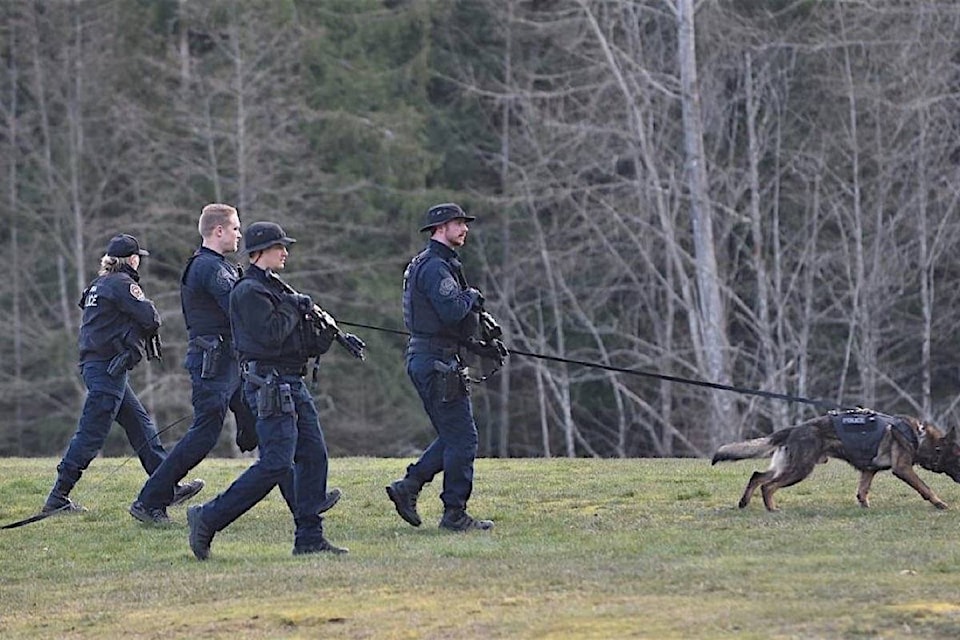Credible reports of armed intruders are rare for B.C. schools, but they do happen.
A middle school in Central Saanich is a recent example, after the administration received multiple student reports on March 1 of a man hiding in bushes near the school with what may have been a weapon.
As most schools do in an annual drill, a lockdown went into effect and police were notified. Doors are locked, students go into closets or under desks, blinds are closed, lights turned off and everyone keeps quiet while the threat is assessed.
At Bayside middle school that day, the regional police Emergency Response Team arrived with an armoured vehicle, extra weapons and a dog handler to search a one-kilometre radius of the school. It would take a nerve-wracking five hours before parents could be told the threat was ended. No suspect was located.
Fortunately a false alarm, this isn’t the case in other situations. Though the history of violent attacks within schools in our country are spread thin, they do happen.
On Jan. 22, 2016, two teachers were fatally shot when a 17-year-old boy opened fire, wounding seven others.
In November of the same year, a 21-year-old was charged with stabbing two female students in an Abbotsford school, where 13-year-old Letisha Reimer later succumbed to her injuries.
Beyond Canada’s gun laws and strong mental health care, the low number of such situations may also be linked to the strategies we have in place.
B.C. Education Minister Rob Fleming says communication, reporting and awareness are keys to the ministry’s system established in 2012, known as the Expect Respect and A Safe Education (ERASE) Bullying Strategy. A review for updates is currently underway.
“When you look at events south of the border, I think school districts are looking for ways they can evaluate whether what we have in B.C. schools is significant enough,” Fleming told Black Press. “A lot of it is acting on tips. Information comes from students talking in the school, that gets to a teacher, maybe a parent, and it’s passed to a principal or a school administrator.”
Quesnel Junior Secondary’s (QJS) principal Suzanne Bolin says protecting students is high priority for her and her staff.
“At QJS we rely on our positive relationships with parents and everyone in the community to report any worrisome behaviours that they might see,” Bolin explains.
“For example, there have been past situations where someone might see something online and then alert us immediately. Working together as a community will be the best way to keep incidents from happening in our schools.”
All schools act under the guidelines of a threat assessment protocol, or Violent Intruders Threat Assessment (V-TRA), a compiled list of procedures and assessment tools which are used by an extensively trained threat assessment team. The team, made up school and school district staff as well as community agency designates from the ministry of children and family development (MCFD) and RCMP, convenes to assess any suspicious activity and handle the situation accordingly.
Correlieu Secondary school’s principal, Dennis Hawkins-Bogle, says: “The intent is to get as much information as possible to determine the level of the threat and also [how] to respond to them.”
This provincial initiative requires an intense three-step training process for the members involved, ensuring staff are prepared for threats to school safety.
“We focus on creating a safe and caring school; creating a threat response team and responding to threats … to self or others.” Hawkins-Bogle explains.
In addition, our school district staff use something they call “fair notice”. If a student implies or reports any sort of threat, whether it be endangering the school as a group or merely the individual reporting the threat, fair notice gives the staff the right to activate the threat assessment protocol. This is also applied to any playful comments intimating threats, where the individual claims they aren’t serious.
Hawkins-Bogle says vigilance is key in any situation that raises red flags, and that it’s their legal responsibility to intercept any suspicious activity.
The ministry’s ERASE Bullying website (www.erasebullying.ca) includes a reporting tool where students can anonymously warn the administration of threats or harassment against students. That includes online harassment, to identify situations that could lead to violence.
In 2017, training for “digital threat assessment” was introduced, and 17,000 staff B.C.-wide have completed the training. A provincial team of experts in violence risk assessment and prevention gives direct support to schools and school districts on high-risk cases and critical incidents.
Minister Fleming notes that local school districts are ultimately responsible for security policies, but all boards of education and independent school authorities must have lockdown procedures in place.
In Quesnel, lockdown drills occur yearly in both primary and secondary schools, and involve all school staff and the RCMP.
Quesnel’s local RCMP are heavily disciplined in the response to situations where schools may be under threat of any kind. Sgt. Chris Riddle says that in the event of an emergency situation such as a violent intruder, the response of the officers is carefully and strategically handled in accordance with their specific training.
B.C. schools are generally designed so almost all doors, internal and external, can be locked, ministry officials say. Many have policies where all doors are kept locked except one close to the office to ensure visitors check in.
Education ministry officials say many B.C. districts have gone to mandatory identification badges for school entry. Some have used the authority available under the School Act to install video surveillance cameras, which requires approval of the individual school planning council.
See Friday’s Observer for more.
